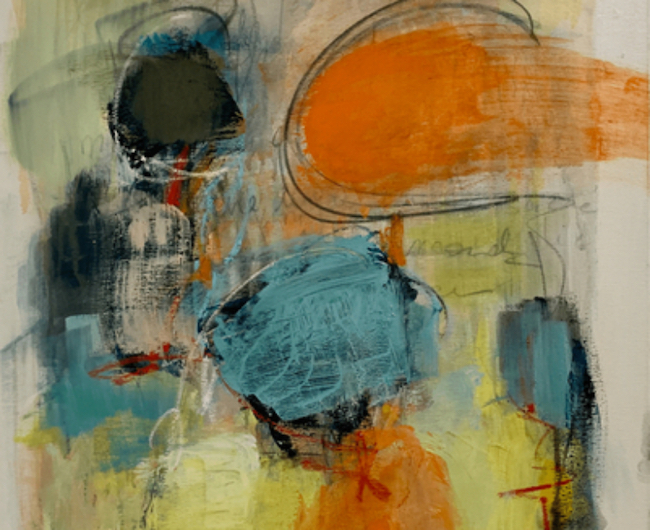Il fascino esercitato dal viaggio, dalla scoperta e dalla conoscenza di luoghi lontani è stato spesso uno spunto essenziale per tutto quel gruppo di artisti che non riuscivano a restare entro i confini del mondo conosciuto, quello in cui erano nati e che poteva costituire un limite alla necessità di esplorare ed entrare in contatto con culture diverse e per questo piene di spunti di ispirazione. Nell’era attuale muoversi e spostarsi è diventato un imperativo imprescindibile alla conoscenza e alla scoperta di sé oppure della mescolanza di origini che proprio in virtù dei grandi spostamenti del secolo scorso si sono generate. La protagonista di oggi esplora non solo le proprie discendenze scoprendo un forte legame istintivo, ed espressivo, con esse, bensì infonde nelle sue opere tutte le sensazioni e l’attitudine all’ascolto che ha appreso nel corso dei suoi numerosi viaggi.
Quando la realtà osservata e lo stile artistico accademico cominciarono a essere troppo legati all’estetica, alla perfezione della forma e all’attinenza a ciò che lo sguardo vedeva davanti a sé, emarginando tutto quel mondo interiore che invece faceva parte non solo dell’essere umano ma anche delle percezioni dell’artista, irruppe nel mondo dell’arte un movimento rivoluzionario, destinato a tracciare un solco indelebile in quelle generazioni successive che avvertivano il bisogno di parlare un linguaggio differente che potesse legarsi in maniera più profonda al loro sentire. I Fauves furono i primi a teorizzare un approccio alla pittura completamente sovversivo rispetto alle regole precedenti, dove la cromaticità forte e intensa doveva prevalere sull’armonia estetica e dove la prospettiva era appiattita, priva di profondità, per infondere le opere di quel senso totalmente emozionale che doveva essere prioritario su qualunque altro principio. André Derain ed Henri Matisse mostrarono anche quanto il tratto grafico fosse essenziale a definire e contenere la vivacità bestiale, come fu definita in termine dispregiativo dagli ambienti culturali di inizio Novecento, della gamma cromatica intensa e decontestualizzata di cui si avvalevano. Ma quegli inizi di secolo segnarono anche un’inedita facilità di spostamento che permise agli artisti di andare a scoprire luoghi lontani ed esotici che poi poterono raccontare con quel nuovo stile, l’Espressionismo, che assunse caratteristiche differenti sulla base dell’emotività di ciascun artista. Pertanto in Francia i tratti e la gamma cromatica più intensa e vicina ai Fauves fu essenziale alla descrizione dei paesaggi polinesiani di Paul Gauguin, considerato anticipatore del movimento, tanto quanto tonalità più tenui e delicate si accordavano perfettamente alle ambientazioni romantiche e alla fuga dalla realtà di Marc Chagall, ebreo nato in Russia e fuggito in Francia durante la guerra, mentre in Nord Europa lo stile si manifestò con una maggiore distorsione delle immagini, con il desiderio di far emergere la distanza tra l’ipocrisia della società borghese contrapposta invece alla spontaneità e all’assenza di regole dei paesi lontani visitati, evidente nelle opere del tedesco Ernest Ludwig Kirchner e del danese Emil Nolde, la cui gamma cromatica era intensa e quasi aggressiva perché affine al loro desiderio di mettere in luce i limiti della realtà quotidiana dell’epoca. Il viaggio, per scoperta o per fuga, era dunque comune denominatore per questi pionieri artistici del Novecento, e fu grazie alla loro curiosità che poterono compiere una profonda ricerca sugli usi e i costumi di paesi fino a poco prima sconosciuti confrontandoli con tutti i difetti della società cosiddetta civile. Erede di questo approccio all’arte, Véronique Besançon, naturalizzata canadese ma di origini francesi, russe e ungheresi e nata in Marocco, avverte dentro di sé quella mescolanza di radici che le permettono di avere un approccio nei confronti del mondo completamente aperto, empatico, e soprattutto di assorbire come una spugna tradizioni, colori, sensazioni che la sua educazione inevitabilmente eclettica le ha lasciato.
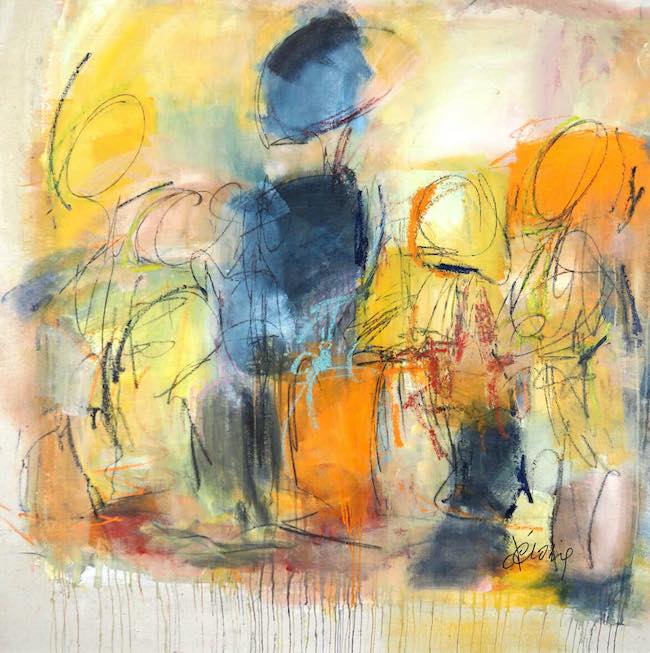
Non solo, i trasferimenti familiari e la sua natura curiosa e interessata a ogni risvolto della bellezza del mondo e di realtà diverse in cui vivere, l’hanno indotta nel tempo a spostarsi frequentemente prima in Francia e poi in Canada, nel Québec, dove ha scelto di vivere, o forse sarebbe meglio dire di tornare tra un viaggio e l’altro.
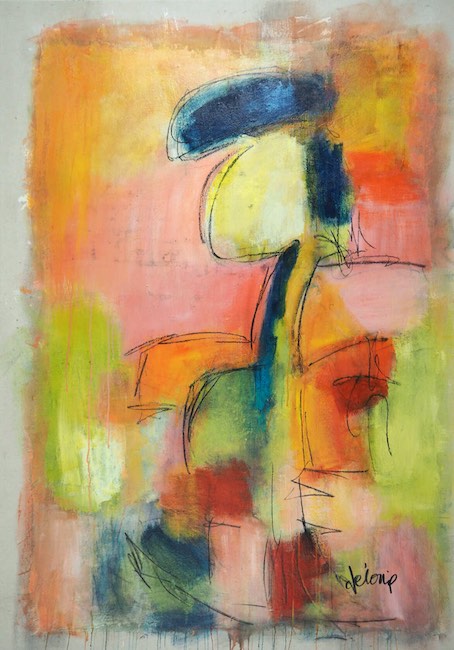
Attraverso la sua capacità di osservazione e la forte sensibilità percettiva, nel momento in cui ha scelto la carriera di artista professionista, a dispetto della sua formazione da autodidatta che avrebbe potuto costituire un limite, ha mescolato all’interno del suo stile pittorico tutte le caratteristiche delle origini familiari, scegliendo i colori caldi dell’area del Mediterraneo, dove è nata e cresciuta, e quelle intense dell’Europa dell’Est, eredità materna, attraverso cui cerca di interpretare, comprendere e lasciar emergere le caratteristiche emozionali dell’essere umano, della sua capacità di interazione a prescindere dalle divisioni che spesso i governanti vorrebbero ci fossero, della bellezza dell’interculturalità, della spontaneità di guardarsi con gli occhi dell’essere umano e non con quelli del colore della pelle, della religione o degli usi e costumi.
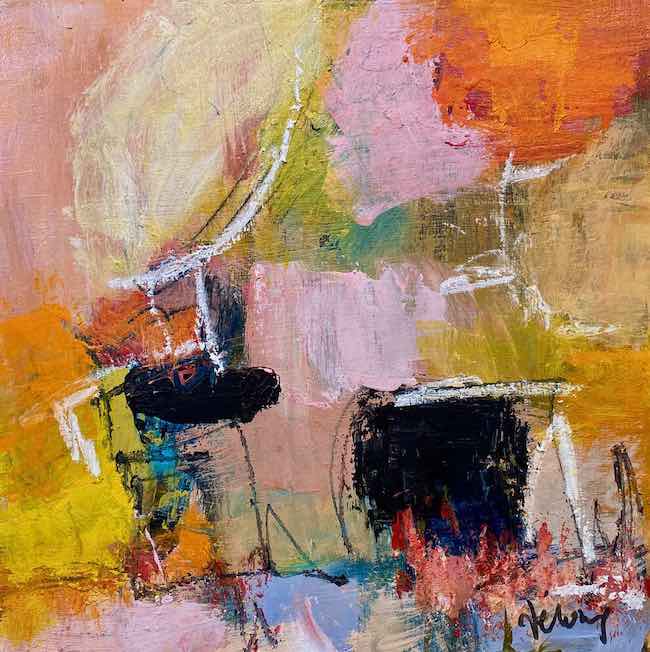
Dal punto di vista stilistico Véronique Besançon si avvicina all’Espressionismo ma lo oltrepassa e lo modifica avvicinandosi a una gestualità di tipo astrattista, sia per la stratificazione della pittura, sia per l’indefinitezza con cui avvolge i suoi personaggi, evidenziandone così le differenze interiori, del sentire, ma non quelle esteriori; tuttavia il tratto grafico con cui definisce i contorni dei protagonisti delle opere e l’interazione con le parole, piccoli e brevi accenni a volte più evidenti e altre invece nascosti dalla pittura, la fanno rientrare di diritto in uno stile espressionista fortemente contemporaneo e arricchito dai concetti e dai messaggi che l’artista desidera lasciare. Tanto è indefinibile il suo complesso e sfaccettato bagaglio culturale proveniente dalle influenze delle sue origini, quanto lo è il suo stile artistico frutto di una personalizzazione necessaria a permetterle di esprimere in maniera forte e intensa il suo approccio alla vita e, di conseguenza, alla pittura.
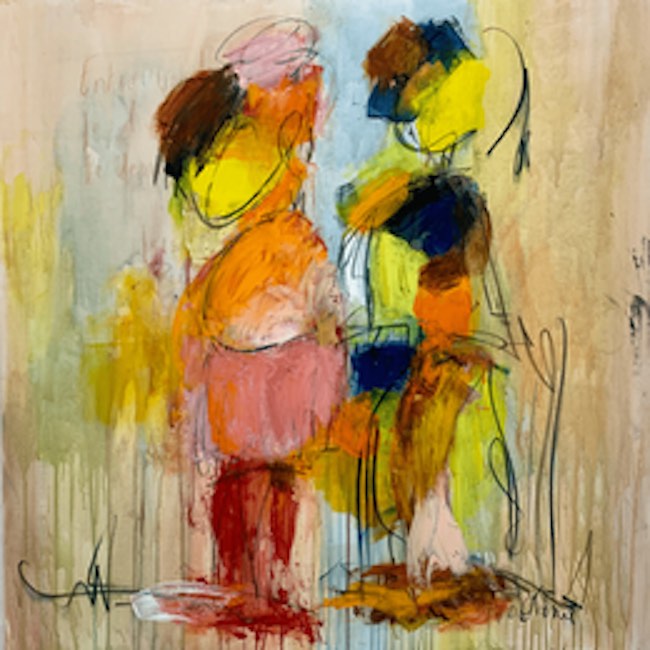
In Entre ventes et marées il disegno di contorno è molto presente e definisce in maniera evidente le figure protagoniste, simbolo di resilienza, di necessità di resistere agli eventi esterni che inevitabilmente fanno parte dell’esistenza e a cui non ci si può che adeguare, modificando le aspettative, generando nuovi obiettivi e adattandosi ai cambiamenti. L’immagine delle due persone infonde nell’osservatore un senso di forza, come se malgrado le maree e i venti evocati dal titolo, riportato quest’ultimo in dissolvenza sul lato sinistro della tela come a generare un’eco, la loro determinazione a restare in piedi fosse ben più potente della possibilità delle circostanze di farli cadere; è una metafora dell’uomo contemporaneo questo dipinto, un esame dell’inconsapevole adattabilità che appartiene alla natura umana.
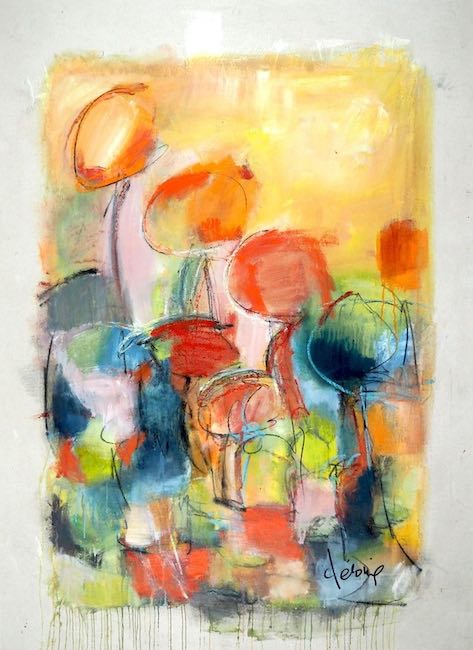
In Je cultive le bonheur dunque, Véronique Besançon mostra quanto le consapevolezze che possono essere acquisite solo attraverso il confronto con il mondo esterno, quanto la fiducia nelle proprie capacità possa fare la differenza nell’evoluzione delle circostanze, perché l’energia positiva non può non generare risultati favorevoli, il susseguirsi di quelle cause ed effetti che conducono l’individuo verso la strada migliore per sé, qualora sia in grado di accettarne anche le improvvise deviazioni. Coltivare il buonumore significa mantenere alte vibrazioni energetiche che modificano la realtà fino a trasformarla in quel sogno che troppo spesso, ed erroneamente, viene visto come una chimera irraggiungibile. La moltitudine di questa tela è unita, compatta, quasi la Besançon volesse sottolineare quanto sia importante mantenere le connessioni tra persone, in un mondo che invece le vorrebbe spesso calate all’interno del loro individualismo e iperconnesse attraverso gli schermi dei computer e dei cellulari, ma di fatto sole.
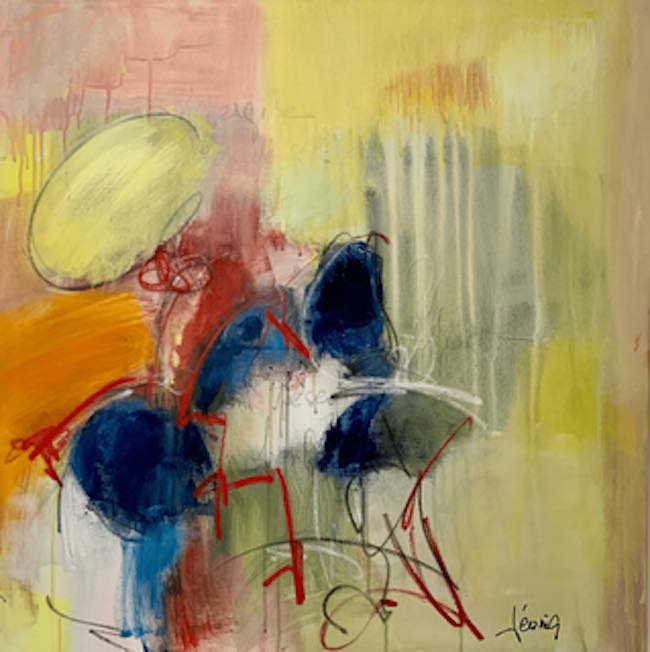
L’opera Je suis l’instant présent invece tende maggiormente verso l’Astrattismo, come se l’artista volesse sottolineare la fuggevolezza del concetto del tempo, quell’inafferrabile affascinante elemento dell’esistenza dentro cui molte persone si cullano dimenticando invece l’importanza dell’urgenza di cogliere le occasioni, di prendere ciò che si desidera prima che non sia più possibile farlo. Vivere il presente è dunque l’unico modo per non rimpiangerlo quando è troppo tardi e le parole che emergono dalla tela, nascoste dal colore, sembrano essere un ricordo di quelle occasioni in cui si è rimasti immobili vedendo sfuggire l’occasione unica legata all’ottenimento di ciò che si desiderava; l’immagine indefinita può rappresentare l’inconsistenza di una vita in cui l’essere umano si è fatto vincere dalla paura di rischiare, oppure la rapidità con cui ha appreso a muoversi e ad agire dopo gli errori del passato.
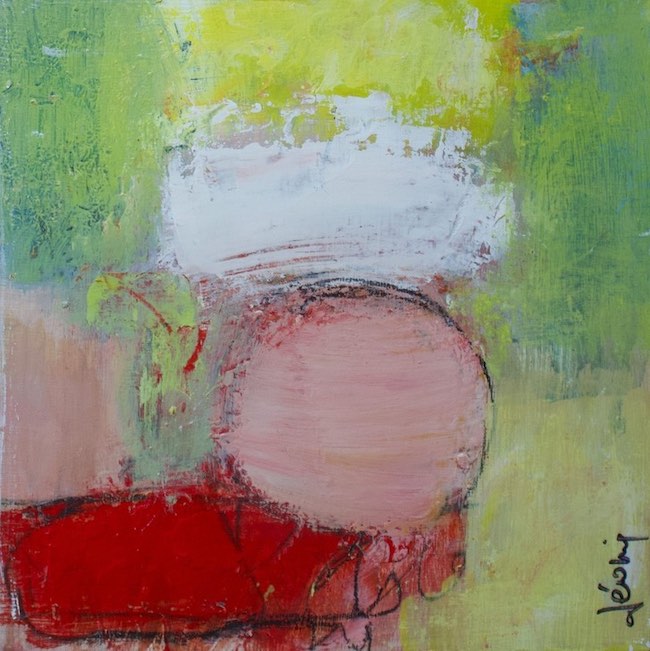
Véronique Besançon, che documenta il suo percorso artistico in raccolte che combinano dipinti e poesie, ha al suo attivo numerose mostre personali e collettive in Canada e in Italia, Austria, Stati Uniti, Marocco, Spagna, Cina, Brasile, Francia e le sue opere fanno parte di collezioni private e pubbliche in Canada, Stati Uniti, Nord Africa ed Europa.
VÉRONIQUE BESANҪON-CONTATTI
Email: contact@veroniquebesancon.com
Sito web: www.veroniquebesancon.com
Facebook: https://www.facebook.com/veronique.besancon.1
Instagram: https://www.instagram.com/veronique_besancon_artist/
Véronique Besançon, between words and colours the research on the human being of a world citizen
The fascination exercised by travelling, discovering and getting to know faraway places has often been an essential cue for that group of artists who could not stay within the confines of the known world, the one in which they were born and which could constitute a limit to the need to explore and come into contact with cultures that are different and therefore full of inspiration. In today’s era, moving and shifting has become an imperative to knowledge and discovery of oneself or of the mixture of origins that have been generated precisely by virtue of the great displacements of the last century. Today’s protagonist not only explores her own desendants by discovering a strong instinctive, and expressive, connection with it, but also infuses her artworks with all the sensations and listening skills she has learnt during her many travels.
When the reality observed and the academic artistic style began to be too tied to aesthetics, to perfection of form and to relevance to what the eye saw in front of it, marginalising all that inner world that was instead part not only of the human being but also of the artist’s perceptions, a revolutionary movement burst into the art world, destined to leave an indelible mark on those later generations who felt the need to speak a different language that could connect more deeply with their feelings. The Fauves were the first to theorise a completely subversive approach to painting compared to previous rules, where strong and intense chromaticity had to prevail over aesthetic harmony and where perspective was flattened, lacking depth, in order to imbue artworks with the totally emotional sense that had to take priority over any other principle. André Derain and Henri Matisse also showed how essential the graphic line was in defining and containing the bestial vivacity, as it was called in derogatory terms by the cultural circles of the early 20th century, of the intense and decontextualised colour range they used. But those early days of the century also marked an unprecedented ease of travel that allowed artists to go and discover faraway and exotic places that they could then narrate with that new style, Expressionism, which took on different characteristics based on the emotionality of each artist. Thus, in France, the most intense strokes and range of colours close to the Fauves were essential to the description of the Polynesian landscapes of Paul Gauguin considered to be a forerunner of the movement, as much as softer and more delicate tones matched the romantic settings and escape from reality of Marc Chagall, a Jew born in Russia who fled to France during the war, while in Northern Europe the style manifested itself with a greater distortion of images, with a desire to bring out the distance between the hypocrisy of bourgeois society as opposed to the spontaneity and lawlessness of the distant countries visited, evident in the works of the German Ernest Ludwig Kirchner and the Dane Emil Nolde, whose chromatic range was intense and almost aggressive because it was akin to their desire to highlight the limitations of the everyday reality of the time.
Travelling, whether by discovery or escape, was therefore a common denominator for these artistic pioneers of the 20th century, and it was thanks to their curiosity that they were able to carry out in-depth research into the customs and traditions of hitherto unknown countries, confronting them with all the faults of so-called civilised society. Heir to this approach to art, Véronique Besançon, naturalised Canadian but of French, Russian and Hungarian origin and born in Morocco, feels within herself that mixture of roots that allow her to have a completely open, empathetic approach to the world, and above all to absorb like a sponge the traditions, colours and sensations that her inevitably eclectic upbringing has left her. Not only that, family relocations and her curious nature, interested in every facet of the beauty of the world and different realities in which to live, induced her over time to move frequently, first to France and then to Canada, to Quebec, where she chose to live, or perhaps it would be better to say to return between trips. Through her capacity of observation and strong perceptive sensitivity, when she chose a career as a professional artist, in spite of her self-taught training that could have been a limitation, she blended within her painting style all the characteristics of her family origins, choosing the warm colours of the Mediterranean area, where she was born and raised, and the intense colours of Eastern Europe, her maternal inheritance, through which she tries to interpret, understand and allow the emotional characteristics of the human being to emerge, of its capacity for interaction regardless of the divisions that rulers often wish to be, of the beauty of interculturality, of the spontaneity of looking at oneself with the eyes of the human being and not with those of skin colour, religion or customs.
From a stylistic point of view, Véronique Besançon approaches Expressionism but goes beyond it and modifies it by approaching an abstractionist type of gestuality, both in the layering of the painting and in the indefiniteness with which she envelops her characters, thus highlighting their inner differences, of feeling, but not their outer ones; however, the graphic line with which she defines the outlines of the protagonists of the artworks and the interaction with words, small and brief hints that are at times more evident and at others hidden by the painting, make her rightfully part of a strongly contemporary expressionist style enriched by the concepts and messages that the artist wishes to leave behind.. As indefinable is her complex and multifaceted cultural background from the influences of her origins, as is her artistic style, the result of a personalisation necessary to allow her to express her approach to life and, consequently, to painting in a strong and intense manner. In Entre ventes et marées, the outline drawing is very present and clearly defines the protagonist figures, a symbol of resilience, of the need to resist external events that are inevitably part of existence and to which one cannot but comply, modifying expectations, generating new goals and adapting to changes. The image of the two people instils in the observer a sense of strength, as if despite the tides and winds evoked by the title, the latter fading on the left side of the canvas as if to generate an echo, their determination to remain standing was far more powerful than the possibility of circumstances to bring them down; it is a metaphor of contemporary man this painting, an examination of the unconscious adaptability that belongs to human nature.
In Je cultive le bonheur, therefore, Véronique Besançon shows how much awareness can only be acquired through confrontation with the outside world, how confidence in one’s own abilities can make all the difference in the evolution of circumstances, because positive energy cannot fail to generate favourable results, the succession of those causes and effects that lead the individual towards the best path for oneself, if one is able to accept even the sudden deviations. Cultivating good humour means maintaining high energy vibrations that modify reality to the point of transforming it into that dream that is too often, and erroneously, seen as an unattainable chimera. The multitude in this canvas is united, compact, almost as if Besançon wanted to emphasise how important it is to maintain connections between people, in a world that would instead often have them immersed in their individualism and hyper-connected through computer and mobile phone screens, but in fact alone. The artwork Je suis l’instant présent, on the other hand, tends more towards Abstractionism as if the artist wanted to emphasise the fleeting nature of the concept of time, that elusive fascinating element of existence within which many people lull themselves, forgetting instead the importance of the urgency of seizing opportunities, of taking what one wants before it is no longer possible to do so. Living the present is therefore the only way not to regret it when it is too late, and the words that emerge from the canvas, hidden by the colour, seem to be a reminder of those occasions when one has stood still, seeing the unique opportunity to get what one wanted slip away; the undefined image may represent the inconsistency of a life in which the human being has let himself be overcome by the fear of taking risks, or the speed with which he has learnt to move and act after past mistakes. Véronique Besançon, who documents her artistic journey in collections combining paintings and poems, has numerous solo and group exhibitions to her credit in Canada and in Italy, Austria, United States, Morocco, Spain, China, Brazil and France, and her artworks are part of private and public collections in Canada, United States, North Africa and Europe.


